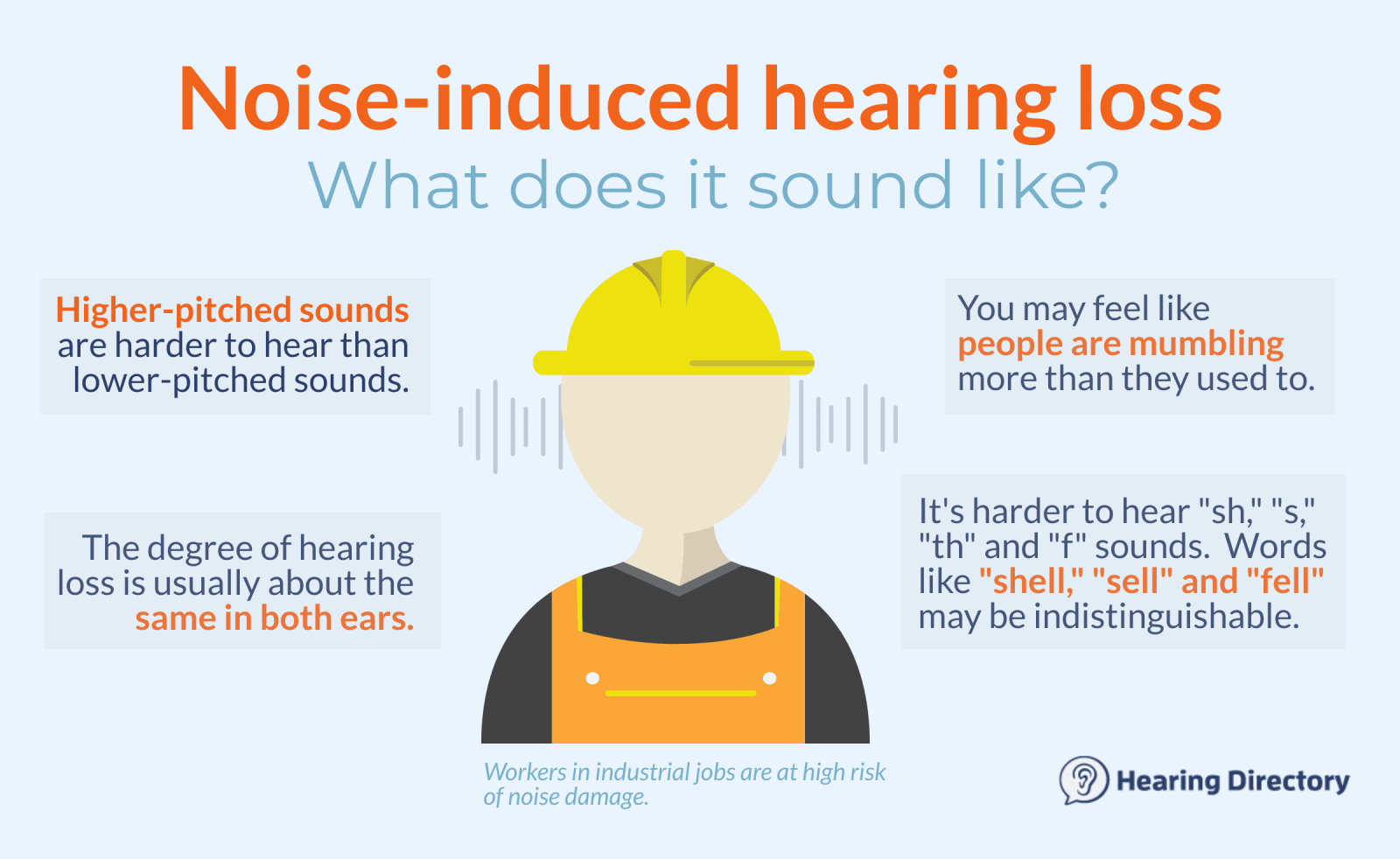|
www.HearingDirectory.ca |
Noise-induced hearing loss causes and treatment
By Vincent Chow, MSc. Aud, Reg. CASLPO, and Shantelle Shakes, coordinator, Hearing Directory Last updated on: February 21st, 2025 Noise-induced hearing loss (NIHL) occurs when the sensitive structures in the inner ear are damaged by loud sound. It often causes permanent hearing loss. Key points:

requirement to protect your hearing health in the long run. Noise-induced hearing loss (NIHL) is caused by excessive noise exposure. It is one of the most common types of hearing loss. It is also on the rise and considered a public health priority. High noise levels can damage the tiny hair cells in your ear that sense sound. This can happen in an instant or can be gradual over time. The good news? While common, NIHL is preventable. And when damage does occur, it is treatable. How long does the hearing loss last?NIHL can be temporary if the hair cells have time to recover after a loud event or incident. If it persists beyond about 30 days, hearing professionals consider it to be permanent. How does hearing damage occur?Hearing damage can occur from impulse noise or continuous noise: Impulse noise is a very loud but brief dosage of sound. Unprotected exposure from impulse noise can cause what's known as "acoustic trauma." This results in permanent hearing damage. Gunfire, fireworks, or a jackhammer are examples of impulse noise. Continuous noise happens over time (e.g. from using a hair dryer often or listening to music at a high volume.) Some work environments have a combination of impulse noise and continuous noise. Who is at risk for NIHL?Anyone is at risk for NIHL, but it's most common among
How common is hearing damage from noise in Canada?According to an estimate drawn from recent Canadian Health Measures Survey data, roughly 42 percent of respondents reported working in noisy environments. This number represents about 11.2 million Canadians. Machinery and transportation were cited as the most common noise sources. People who had a long history of working in a noisy place (10+ years) were more likely to report they had hearing loss and/or tinnitus than those who reported never working in a noisy environment. Many of the survey respondents reported that hearing protection was required at work, but only about a third of them indicated they always used it. NIHL is prevalent outside of work too, the survey showed, especially among teens and younger adults, particularly males. The most common leisure noise sources include amplified music, stereo listening and power tools. Based on the survey results, researchers estimate that 6.6 million Canadians are at risk of hearing damage from leisure activities. Key symptoms of noise-induced hearing lossMany people will experience some signs and symptoms of NIHL:
How does noise affect my hearing?A person with NIHL may struggle to hear speech sounds such as “sh”, “s”, “th” and “f”. It is most noticeable at the start and end of a word; “shell”, “sell” and “fell” may be difficult to distinguish. This makes speech sound more mumbled and less crisp or clear than it should.
Can noise damage cause tinnitus?Yes. Tinnitus is a ringing, whooshing or buzzing sound in one or both ears, sometimes called ear ringing. You may hear it after loud noise exposure, such as after a concert. How it happens: The hair cells in your ear send impulses to your brain to help you register sound. Noise can cause tinnitus when hair cells are damaged by sound, sending false sound signals to your brain. These false sound signals can produce a ringing sound. About half of Canadians who worked in noisy environments developed tinnitus, according to the survey data mentioned above. While that isn't proof that the noise exposure directly caused tinnitus, noise is a known risk factor. The good news? Noise-induced tinnitus can be temporary. Still, if the damage to your hair cells is severe, it can be permanent. Fortunately, there are tinnitus treatment options to help you cope with ear ringing. Other harmful effectsStress-related problems are also linked to noise exposure. These problems include sleep disturbances, high blood pressure, heart disease and diabetes. Diagnosis and treatment of NIHLDiagnosis starts with a hearing test. Your workplace may offer on-site hearing screenings for at-risk workers, or even have you take annual hearing tests. If you suspect you have workplace NIHL, talk to a hearing care professional. Is there a cure for NIHL?Unfortunately, there is no official cure for NIHL. The best treatment is often hearing aids. There is no drug or medication that works for NIHL. In Canada, your workers' insurance board may offer you coverage for hearing aids. Speak to your hearing care professional for more information. 
exposure to any sound above 85 decibels. Noise levels of common soundsEven everyday household items can put you at risk for NIHL. Hair dryers, kitchen blenders, lawnmowers and electric drills can all damage your hearing. It is generally advised to avoid or limit exposure to any sound above 85 decibels. This also depends on how often, the length of exposure and how close you are in proximity to the sound. Here's some general guidance on hearing loss decibels: How loud is too loud?To understand how loud is too loud, it helps to know the concept of "duration-level trade off." Hearing damage is a factor of how loud the sound is and how long the exposure is. The louder the noise, the less time you should spend exposed to it unprotected. For the average person, an exposure of 85dB is safe up to eight hours. This "safe zone" is an estimate. Some people are more vulnerable depending on their genetics. For some, exposure to less than this limit can still cause hearing loss. Hearing professionals recommend you take "noise breaks" to get away from noise exposure. And if you have to raise your voice to communicate at one arm's length away, wear hearing protection. Workplace limits for noise levels in CanadaEach province/territory regulates noise exposure limits in the workplace. The longest permitted exposure time is eight hours, which assumes you are in quiet the remaining 16 hours. This exposure allowance changes if a person has noisy hobbies. Some provinces and territories have a mandatory hearing conservation program. The program is enforced when workplace noise exceeds a certain level. This level varies depending on the province or territory. Elements of a hearing conservation program include:
Learn more about workplace noise limits in your jurisdiction. Noise protection and NIHL preventionTo help protect you from excessive noise, some apps like NIOSH Sound Level Meter for iPhone or Sound Meter for Android give you a real-time estimate of noise levels in your environment. Many Apple devices have built-in hearing monitors using the Health app as well. Does NIHL get worse over time?Yes, it can, especially if you don't protect your hearing. If you have a hearing loss, you should have annual checks to track changes in your hearing. Practice hearing loss prevention techniques and wear hearing protection to preserve your hearing. Noise protection is available in many styles, such as ear plugs (worn in the canal) or ear muffs (over the canal) — or both. Vincent Chow, MSc. Aud, Reg. CASLPO
Shantelle Shakes, coordinator, Hearing Directory
You are reading about: Related topics
More information about hearing aids. Featured clinics near me
Schedule a hearing test with Healthy Hearing. Find a clinicThe Healthy Hearing Report |
|
www.HearingDirectory.ca |
Noise-induced hearing loss causes and treatment
By Vincent Chow, MSc. Aud, Reg. CASLPO, and Shantelle Shakes, coordinator, Hearing Directory Last updated on: February 21st, 2025 Noise-induced hearing loss (NIHL) occurs when the sensitive structures in the inner ear are damaged by loud sound. It often causes permanent hearing loss. |
 Are you located in the United States?
Are you located in the United States?



 Contributing author Vincent Chow earned a bachelor’s degree in kinesiology from McMaster University before completing a Master of Science degree in audiology at Dalhousie University. He is currently a clinical audiologist, working with clients of all ages that are affected by hearing loss, tinnitus and vertigo, as well as working collaboratively with ear, nose and throat (ENT) surgeons. Vincent enjoys and actively participates in community outreach, performing hearing screenings and speaking engagements. He is interested in current industry trends and continually strives to stay up to date on the applications of wearable technology to better serve his clients. Vincent lives in York Region and is registered with the College of Audiologists and Speech-Language Pathologists of Ontario.
Contributing author Vincent Chow earned a bachelor’s degree in kinesiology from McMaster University before completing a Master of Science degree in audiology at Dalhousie University. He is currently a clinical audiologist, working with clients of all ages that are affected by hearing loss, tinnitus and vertigo, as well as working collaboratively with ear, nose and throat (ENT) surgeons. Vincent enjoys and actively participates in community outreach, performing hearing screenings and speaking engagements. He is interested in current industry trends and continually strives to stay up to date on the applications of wearable technology to better serve his clients. Vincent lives in York Region and is registered with the College of Audiologists and Speech-Language Pathologists of Ontario.
 Shantelle Shakes is the coordinator for Hearing Directory. She has over nine years of experience in the health industry, with eight of those years in hearing healthcare. After graduating from York University with an honours BA in professional writing, minor in creative writing, Shantelle began her marketing career with a major hearing healthcare provider. Through a variety of roles within that company, Shantelle gained a thorough understanding of hearing health and the client experience. She aims to use her knowledge of the industry as well as her communications background to help others understand their hearing and connect with the hearing care they need.
Shantelle Shakes is the coordinator for Hearing Directory. She has over nine years of experience in the health industry, with eight of those years in hearing healthcare. After graduating from York University with an honours BA in professional writing, minor in creative writing, Shantelle began her marketing career with a major hearing healthcare provider. Through a variety of roles within that company, Shantelle gained a thorough understanding of hearing health and the client experience. She aims to use her knowledge of the industry as well as her communications background to help others understand their hearing and connect with the hearing care they need.